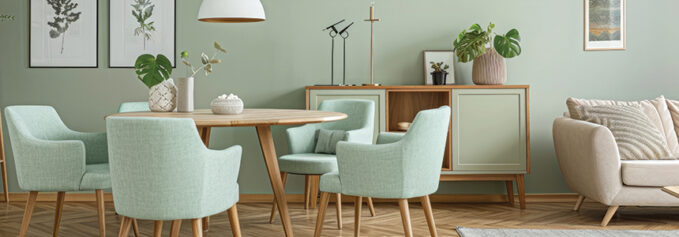
by Melissa Donovan
The flooring market was an early adopter of digital printing technology for surface decoration. Exploring further into the décor segment, there are many benefits to using digital printing for decorative surfaces that go on to be used in pieces of furniture like bar tops or kitchen islands.
Above: Wood tabletop and flooring printed digitally with Agfa printing technologies.
“As demand for shorter production runs and bold, bespoke designs increases, furniture manufacturers explore new strategies for decorative surface printing. The industry is witnessing a transformative shift from traditional gravure methods to digital inkjet printing, and manufacturers reap the benefits of unprecedented flexibility and the ability to create standout patterns with unmatched speed and efficiency,” shares Marc Graindourze, business manager industrial inks, Agfa NV.
Accelerating Adoption
Educating furniture manufacturers about the power of digital print is a commitment, but one many vendors in this space are willing to take.
Adoption is based on market trends, according Michael Hesse, head sales, Hymmen GmbH Maschinen- und Anlagenbau. “If in the furniture industry unicolored surfaces dominate the market trend, other production technologies are more relevant. But as soon as the demand for other optics like wood or stone décor rises, digital printing comes into focus.”
“It always takes a while until a market adopts new technologies. Until now there are only niche producers for very special applications that benefit from the advantages of digital technology, but as soon as a market leader, e.g. in the kitchen industry, decides on digital printing this can become the trailblazer for this technology,” shares Hesse.
Graindourze says one way to accelerate the adoption of digital printing in furniture manufacturing is by partnering with technology providers. This can further help to lower adoption risks and unlock the full potential of digital printing in this sector.
Top Advantages
Digital print presents many opportunities to create decorative designs for surfaces used in furniture.
It offers flexibility, fast setup times, and individualization, points out Hesse.
“Less décor repetition and faster design development cycles are helping producers be ahead of competition with digital printing. No matter which décor you want to print—everything from wood over stone to artificial designs can be realized and exactly reproduced again at any time,” says Hesse.
It’s not surprising that digital inkjet technology is growing in the décor market. According to Graindourze, “unlike analog printing, digital processes support instant design changes and just-in-time manufacturing, catering perfectly to the trend towards ultra-bespoke interiors for residential, hospitality, and commercial spaces.”
As more furniture manufacturers realize the total cost of ownership of digital compared to analog print methods like gravure, the adoption of digital printing for decorative surfaces will grow.
Graindourze points out that analog print methods like gravure can be very efficient for large runs, but the considerable setup costs make them prohibitively expensive for shorter, smaller jobs. Coupled with the cost of bespoke cylinders for each design, lengthy design changes, and warehousing requirements for print masters, conventional analog methods prove unviable for many businesses.
“In contrast, digital printing offers highly efficient production even at small scale or variable batch lengths. With digital, every print can be unique, transition times between jobs are minimal, and customization becomes more economically accessible. More efficient printing means manufacturers can reduce ink consumption, material usage, and lower energy bills, supporting enhanced sustainability,” notes Graindourze.
Beyond practical benefits like lower energy bills and reduced material usage, digital printing opens up endless possibilities on a creative level.
“Digital printing unlocks true creative freedom, as new patterns or textures can be implemented without new hardware or major investments, requiring only a print file to operate. Modern print engines and specialist ink sets empower manufacturers to print directly onto a staggering array of substrates, creating high-quality prints on everything from wood panels to laminated décor paper. This flexibility enables companies to deliver intricate detailing such as natural woodgrains and bespoke graphics directly onto furniture parts, eliminating the long lead times and minimum order quantities associated with analog processes,” shares Graindourze.
A derivative of the print process is digital structure printing, where the ink is built up or embossed to provide textures and other tangible elements. This is an interesting use of digital print in the furniture industry.
Digital Lacquer Embossing (DLE) by Hymmen involves the creation of structures that are embossed in register to the décor of the surface. Hymmen’s patented technology achieves these results by printing a transparent liquid medium into a layer of structure lacquer using the Hymmen JUPITER Digital Printing Lines.
“Digital structuring supports surface performance. All features like hardness, bonding, scratch resistance, and chemical reliability of the core lacquer are remaining. Digital structuring offers even more design options for the furniture industry—structures on a unicolored surface are a highly interesting alternative to classic décor,” notes Hesse.
Hardware Notes
With a variety of hardware configurations and ink technologies out there, the best for decorative surface printing of furniture items is determined by whether the graphics look realistic and more importantly can handle wear and tear.
One thing to consider is whether a single- or multi-pass printer is effective. “The advantages of single- or multi-pass technologies depend on the needed capacity of the production line,” admits Hesse.
Certain patented technologies can work with either. Hymmen digital printing solutions for the furniture industry cover individual customers’ capacity needs and individual production processes. For example, Hymmen’s DLEplus is designed to work on its own JUPITER JPT-C single-pass UV printers, but can also be combined with a multi-pass device.
Both single- and multi-pass technologies have respective advantages and disadvantages, agrees Graindourze, with the best one to use depending heavily on application requirements. Choosing the right approach depends on desired throughput, investment capacity, and substrate compatibility.
“In particular, multi-pass systems like Agfa’s InterioJet provide flexible configurations for short to medium runs, with high print quality and efficiency, whereas single-pass systems excel at high throughput production. This makes them attractive for manufacturers seeking to replace or complement gravure lines in high-volume settings,” explains Graindourze.
In addition to whether to use a single- or multi-pass printer, the ink set chosen is important. Graindourze says it must be tailored for decorative applications to ensure compatibility and quality.
UV LED and water-based inks are two popular choices, though not just any standard CMYK ink will do, cautions Graindourze.
“Matching the realism of wood or stone, especially between edge bands and adjacent panels, requires precise control over ink formulation, color management, and substrate preparation. Standard CMYK inks developed for the commercial and packaging sectors simply cannot deliver the necessary hues or meet the lightfastness requirements of a high-end decorative surface,” explains Graindourze.
Graindourze points out that in the furniture sector, specialized pigments are required—like a specific red pigment instead of the standard magenta pigment—to enable printers to match the vast range of natural wood tones while avoiding color distortions caused by metamerism.
New Heights
Digital printing of decorative surfaces, particularly furniture, is in the early stages. Adopters of the technology enjoy the advantages of flexibility, fast setup times, and personalization.
“Digital printing is propelling the decorative surfaces sector toward a new era of personalization, sustainability, and design innovation. As print engines, ink formulations, and automation technologies continue to advance, digital printing will help further refine aesthetics and provide those who embrace it with a powerful competitive edge. Manufacturers that embrace digital printing today set the standard for quality and efficiency in the sector,” concludes Graindourze.
Oct2025, Industrial Print Magazine



